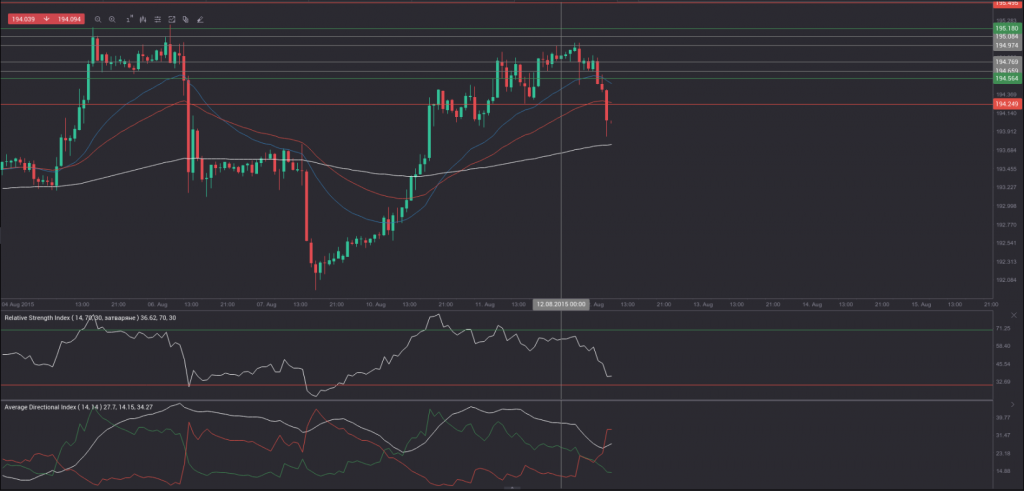Yesterday’s trade saw GBP/JPY within the range of 193.90-195.03. The pair closed at 194.87, surging 0.28% on a daily basis and extending gains from Monday. The daily high has also been the highest level since August 6th, when the cross registered a high of 195.28.
At 7:43 GMT today GBP/JPY was down 0.43% for the day to trade at 194.01. The pair overcame the lower range breakout level (S4) and touched a daily low at 193.93 at 7:49 GMT.
Today the cross may be influenced by a number of macroeconomic reports as listed below.
Fundamentals
United Kingdom
Jobless claims, ILO unemployment rate
The number of jobless claims in the United Kingdom probably rose by 1 500 in July, according to market expectations. In June the number of claims went up by 7 000, which followed 31 consecutive months of declines. At the same time, the claimant count rate, which represents the percentage change of jobless claims compared to the entire work force, probably remained steady at 2.3% for a fifth straight month in July. It has been the lowest claimant count rate in at least 8 years.
The rate of unemployment in the UK, estimated in accordance with ILO (International Labour Organization) standards, probably remained steady at 5.6% during the three months to June compared to the same period a year ago. The three-month period to May marked the first increase in the unemployment rate (from 5.5% to 5.6%) since 2013.
During the period March-May there were 30.98 million people in employment, or a decrease by 67 000 compared to the three months to February. It has been the first quarterly drop since the period February-April 2013. Compared to March-May 2014, the figure represented an increase by 265 000.
During the period March-May 1.85 million people were unemployed, or 15 000 more than in the three months to February. It has been the first quarterly increase since the period January-March 2013. Compared to March-May 2014, the figure represented a decrease by 273 000.
In March to May 2015 there were 9.02 million people aged between 16 and 64, who were out of work and not seeking or available for employment, according to data by the Office for National Statistics (ONS). This represented an increase by 30 000 compared to the three-month period to February 2015 and also an increase by 104 000 compared to March-May 2014.
The rate of unemployment refers to the percentage of economically active people, who are currently unemployed. According to the ILO approach, people who are considered as unemployed are either: 1) out of work, but are actively searching for employment, or 2) out of work and are waiting to be hired again during the next two weeks.
The ILO Unemployment Rate is based on a monthly survey, known as the Labour Force Survey in the United Kingdom, with approximately 40 000 individuals being interviewed every month. This indicator reflects overall economic state in the country, as there is a strong correlation between consumer spending levels and labor market conditions. Low rates of unemployment are accompanied by higher spending, which causes a favorable effect on corporate profits and also accelerates overall growth. In case the rate of unemployment met expectations or fell even further while the number of claims increased less than projected, this would certainly have a bullish effect on the sterling. The official report by the ONS is due out at 8:30 GMT.
Japan
Machinery Orders
Machinery orders in Japan probably dropped 5.6% in June compared to a month ago, according to the median forecast by experts, after three consecutive monthly increases. In annual terms, new orders, placed at major manufacturers in Japan, probably rose 16.4% in June. If so, this would be the seventh month in a row, during which machinery orders went up. In May new orders increased at an annualized rate of 19.3%, or the sharpest one since January 2014, when they surged 23.6%.
Machinery orders are considered as an excellent leading indicator, providing clues over business capital spending in Japan. An increase in new orders suggests that business confidence has strengthened, which can also raise hopes over the nations economic growth. Therefore, in case new orders increased at a faster-than-anticipated pace, this would provide a positive impulse for the yen. Japanese Cabinet Office will release the official report at 23:50 GMT.
Bond Yield Spread
The yield on Japanese 2-year government bonds went as high as 0.013% on August 11th, or the highest level since August 6th (0.014%), after which it slid to 0.010% at the close to lose 0.001 percentage point on a daily basis.
The yield on UK 2-year government bonds climbed as high as 0.620% on August 11th, after which it fell to 0.581% at the close to lose 4.7 basis points (0.047 percentage point) for the day.
The spread between 2-year UK and 2-year Japanese bond yields, which reflects the flow of funds in a short term, narrowed to 0.571% on August 11th from 0.617% during the prior day. The August 11th difference has been the lowest one since August 4th, when the yield spread was 0.570%.
Meanwhile, the yield on Japans 10-year government bonds soared as high as 0.420% on August 11th, after which it slid to 0.406% at the close to lose 0.002 percentage point compared to August 10th, while marking a third consecutive trading day of decrease.
The yield on UK 10-year government bonds climbed as high as 1.932% on August 11th, after which it slipped to 1.828% at the close to lose 9.4 basis points (0.094 percentage point) on a daily basis.
The spread between 10-year UK and 10-year Japanese bond yields shrank to 1.422% on August 11th from 1.514% during the prior day. The August 11th yield difference has been the lowest one since July 7th, when the spread was 1.353%.
Taking into account the period January-July 2015 and basing our calculations on weekly closing prices, we came to the conclusion that GBP/JPY performance and the development of the yield spread between 10-year bonds in the United Kingdom and Japan showed a correlation of 0.8613, or the pair and the spread moved almost equally in one and the same direction. As the yield spread grew in favor of the 10-year UK bonds, the UK pound advanced against the Japanese yen. During the period January-July, GBP/JPY has appreciated 7.77%, while the spread between 10-year bond yields in both countries has widened 12.56% to reach approximately 1.47% in late July from approximately 1.31% in early January.
Daily and Weekly Pivot Levels
By employing the Camarilla calculation method, the daily pivot levels for GBP/JPY are presented as follows:
R1 – 194.97
R2 – 195.08
R3 (range resistance – green on the 30-minute chart) – 195.18
R4 (range breakout – red on the 30-minute chart) – 195.49
S1 – 194.77
S2 – 194.66
S3 (range support – green on the 30-minute chart) – 194.56
S4 (range breakout – red on the 30-minute chart) – 194.25
By using the traditional method of calculation, the weekly pivot levels for GBP/JPY are presented as follows:
Central Pivot Point – 193.23
R1 – 194.55
R2 – 196.60
R3 – 197.92
S1 – 191.18
S2 – 189.86
S3 – 187.81






